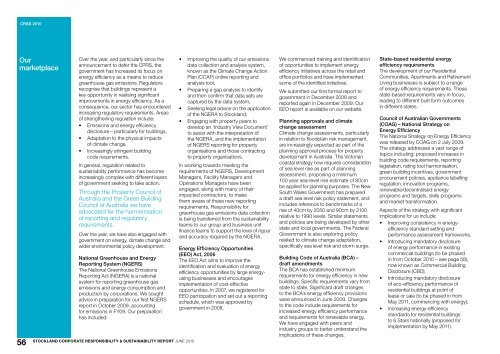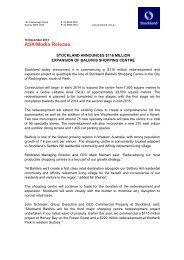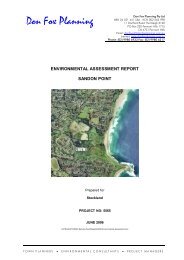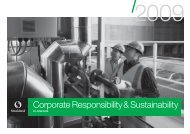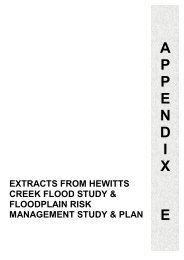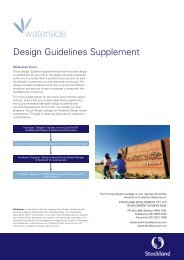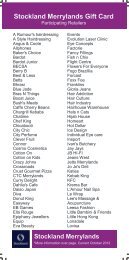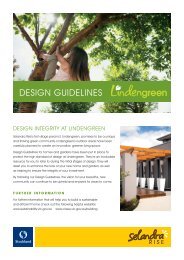Download PDF - Stockland
Download PDF - Stockland
Download PDF - Stockland
You also want an ePaper? Increase the reach of your titles
YUMPU automatically turns print PDFs into web optimized ePapers that Google loves.
CR&S 2010<br />
Our<br />
marketplace<br />
56<br />
Over the year, and particularly since the<br />
announcement to defer the CPRS, the<br />
government has increased its focus on<br />
energy efficiency as a means to reduce<br />
greenhouse gas emissions. Regulators<br />
recognise that buildings represent a<br />
key opportunity in realising significant<br />
improvements in energy efficiency. As a<br />
consequence, our sector has encountered<br />
increasing regulatory requirements. Areas<br />
of strengthening regulation include:<br />
• Emissions and energy efficiency<br />
disclosure – particularly for buildings,<br />
• Adaptation to the physical impacts<br />
of climate change,<br />
• Increasingly stringent building<br />
code requirements.<br />
In general, regulation related to<br />
sustainability performance has become<br />
increasingly complex with different layers<br />
of government seeking to take action.<br />
Through the Property Council of<br />
Australia and the Green Building<br />
Council of Australia we have<br />
advocated for the harmonisation<br />
of reporting and regulatory<br />
requirements.<br />
Over the year, we have also engaged with<br />
government on energy, climate change and<br />
wider environmental policy development.<br />
National Greenhouse and Energy<br />
Reporting System (NGERS)<br />
The National Greenhouse Emissions<br />
Reporting Act (NGERA) is a national<br />
system for reporting greenhouse gas<br />
emissions and energy consumption and<br />
production by corporations. We sought<br />
advice in preparation for our first NGERS<br />
report in October 2009, accounting<br />
for emissions in FY09. Our preparation<br />
has included:<br />
<strong>Stockland</strong> Corporate Responsibility & Sustainability Report June 2010<br />
• Improving the quality of our emissions<br />
data collection and analysis system,<br />
known as the Climate Change Action<br />
Plan (CCAP) online reporting and<br />
analysis tool,<br />
• Preparing a gap analysis to identify<br />
and then confirm that data sets are<br />
captured by the data system,<br />
• Seeking legal advice on the application<br />
of the NGERA to <strong>Stockland</strong>,<br />
• Engaging with property peers to<br />
develop an ‘Industry View Document’<br />
to assist with the interpretation of<br />
the NGERA, and the implementation<br />
of NGERS reporting for property<br />
organisations and those contracting<br />
to property organisations.<br />
In working towards meeting the<br />
requirements of NGERS, Development<br />
Managers, Facility Managers and<br />
Operations Managers have been<br />
engaged, along with many of their<br />
impacted contractors, to make<br />
them aware of these new reporting<br />
requirements. Responsibility for<br />
greenhouse gas emissions data collection<br />
is being transferred from the sustainability<br />
teams to our group and business unit<br />
finance teams to support the level of rigour<br />
and accuracy required by the NGERA.<br />
Energy Efficiency Opportunities<br />
(EEO) Act, 2006<br />
The EEO Act aims to improve the<br />
identification and evaluation of energy<br />
efficiency opportunities by large energyusing<br />
businesses and encourages<br />
implementation of cost-effective<br />
opportunities. In 2007, we registered for<br />
EEO participation and set out a reporting<br />
schedule, which was approved by<br />
government in 2008.<br />
We commenced training and identification<br />
of opportunities to implement energy<br />
efficiency initiatives across the retail and<br />
office portfolios and have implemented<br />
some of the identified initiatives.<br />
We submitted our first formal report to<br />
government in December 2008 and<br />
reported again in December 2009. Our<br />
EEO report is available on our website.<br />
Planning approvals and climate<br />
change assessment<br />
Climate change assessments, particularly<br />
in relation to floodplain risk management,<br />
are increasingly expected as part of the<br />
planning approval process for property<br />
development in Australia. The Victorian<br />
coastal strategy now requires consideration<br />
of sea level rise as part of planning<br />
assessment, proposing a minimum<br />
100 year sea-level rise estimate of 80cm<br />
be applied for planning purposes. The New<br />
South Wales Government has prepared<br />
a draft sea level risk policy statement, and<br />
includes reference to benchmarks of a<br />
rise of 40cm by 2050 and 90cm by 2100<br />
relative to 1990 levels. Similar statements<br />
and policies are being developed by other<br />
state and local governments. The Federal<br />
Government is also exploring policy<br />
related to climate change adaptation,<br />
specifically sea level risk and storm surge.<br />
Building Code of Australia (BCA) –<br />
draft amendments<br />
The BCA has established minimum<br />
requirements for energy efficiency in new<br />
buildings. Specific requirements vary from<br />
state to state. Significant draft changes<br />
to the BCA’s energy efficiency provisions<br />
were announced in June 2009. Changes<br />
to the code include requirements for<br />
increased energy efficiency performance<br />
and requirements for renewable energy.<br />
We have engaged with peers and<br />
industry groups to better understand the<br />
implications of these changes.<br />
State-based residential energy<br />
efficiency requirements<br />
The development of our Residential<br />
Communities, Apartments and Retirement<br />
Living businesses is subject to a range<br />
of energy efficiency requirements. These<br />
state-based requirements vary in focus,<br />
leading to different built form outcomes<br />
in different states.<br />
Council of Australian Governments<br />
(COAG) – National Strategy on<br />
Energy Efficiency<br />
The National Strategy on Energy Efficiency<br />
was released by COAG on 2 July 2009.<br />
The strategy addresses a vast range of<br />
topics including: proposed increases in<br />
building code requirements, reporting<br />
legislation, rating tool harmonisation,<br />
green building incentives, government<br />
procurement policies, appliance labelling<br />
regulation, innovation programs,<br />
renewable/decentralised energy<br />
programs and targets, skills programs<br />
and market transformation.<br />
Aspects of the strategy with significant<br />
implications for us include:<br />
• Improving consistency in energyefficiency<br />
standard setting and<br />
performance assessment frameworks,<br />
• Introducing mandatory disclosure<br />
of energy performance in existing<br />
commercial buildings (to be phased<br />
in from October 2010 – see page 58),<br />
now known as Commercial Building<br />
Disclosure (CBD),<br />
• Introducing mandatory disclosure<br />
of eco-efficiency performance of<br />
residential buildings at point of<br />
lease or sale (to be phased in from<br />
May 2011, commencing with energy),<br />
• Increasing energy-efficiency<br />
standards for residential buildings<br />
to 6 Stars nationally (proposed for<br />
implementation by May 2011).


